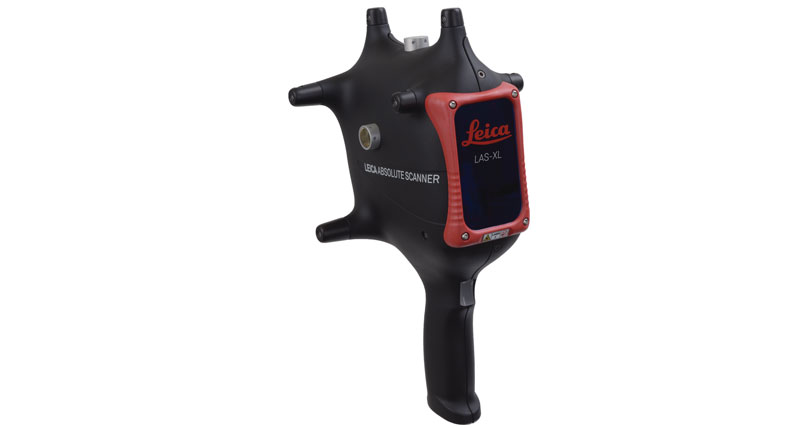Winning Olympic medals with Leica Absolute Scanner LAS and LAS-XL
Assessing how geometry influences the performance of vessels in the water
Contact us
Optimising racing kayak performance with fluid dynamics analysis
Sailing and canoeing are two of the sports that have given the most Olympic medals to Spain throughout the country’s history. To achieve these sporting successes, great athletes are needed, but also a lot of research to improve the results.
 Just as athletes are subjected to intense training, their boats are also subject to constant scrutiny to determine if any small detail can contribute to earning another of the valuable tenths of a second needed to achieve victory.
Just as athletes are subjected to intense training, their boats are also subject to constant scrutiny to determine if any small detail can contribute to earning another of the valuable tenths of a second needed to achieve victory.
For this, the Spanish sailing and canoeing federations have a collaboration agreement with the National Institute of Aerospace Technology (INTA), a body under the Spanish Ministry of Defence that makes available to these entities the facilities of the Hydrodynamic Experiences Centre of El Pardo (CEHIPAR), a unique scientific and technical structure in Madrid created in 1928 by the Spanish Navy.
Equipped with one channel of calm water, another with a wave generator and several cavitation tunnels and ship dynamics laboratories, CEHIPAR has an experienced team of naval engineering and architecture researchers dedicated to the manufacture of scale models of boat hulls and propellers.
“Among other things, in the CEHIPAR we make boat hulls with a wide range of sizes. They tend to vary between two and fifteen metres in length, while the propellers at scale can be between 200 and 350 millimetres in diameter,” says Enrique Molinelli, researcher and naval engineer at INTA.

Precision in the manufacture of these components is vital. In the case of the boat models, the CEHIPAR requires precision to within just one millimetre, while in the case of the propellers, the margin of error cannot exceed 50 microns.
“What we are looking for in the CEHIPAR is ways to analyse how geometry influences the performance of vessels within the water,” explains Molinelli.
To achieve the maximum possible precision in the dimensional control of the hulls and propellers and be able to verify that they have been built according to the established standards, this research centre has successfully used technology provided by Hexagon for almost a decade.
“Nearly ten years ago we started working with a portable measuring arm. Later we upgraded to using an Absolute Arm with a probe, then one with a laser scanner. We are now also working with a Leica Absolute Tracker with a Leica Absolute Scanner LAS handheld laser scanner,” explains Molinelli.
With one or two hours using this equipment we can make a comprehensive report, a task that before could take us between two and three days of work.“Thanks to Hexagon’s technology, we are able to check the exact dimensions of a complete object of any size in a very short time. With one or two hours using this equipment we can make a comprehensive report, a task that before could take us between two and three days of work,” says the INTA researcher, who during our visit was scanning the different kayaks used by the ‘dream team’ of Spanish canoeing – Saúl Craviotto (four Olympic medals, two of them gold), Cristian Toro (champion in Rio 2016 in K2 200), Marcus Cooper (champion in Rio in 1000 K1) and Rodrigo Germade (world champion in K2 200 in 2017).
 “The technology provided by Hexagon makes our lives easier, because we can scan very fast models of large vessels, with lengths ranging from five to fifteen metres. With a mechanical arm, this would be a process of many hours, because you have to move and adjust it constantly to cover different areas, but with a laser scanner like this we can do that job in just half an hour,” explains Molinelli.
“The technology provided by Hexagon makes our lives easier, because we can scan very fast models of large vessels, with lengths ranging from five to fifteen metres. With a mechanical arm, this would be a process of many hours, because you have to move and adjust it constantly to cover different areas, but with a laser scanner like this we can do that job in just half an hour,” explains Molinelli.
Another of the great advantages of the technology provided by Hexagon that Molinelli highlights is its extraordinary usability.
“The Hexagon teams are giving us the ability to make verifications on a complete surface in a very short time and with the minimum human and mechanical resources,” says Molinelli, who is delighted with the customer service provided by Hexagon.
The CEHIPAR has a staff of five people qualified to use Hexagon technology thanks to the training offered by the company at the time of installing the equipment.

“As part of our acquiring this technology, Hexagon is giving us a complete three-day training course, following which we can already start to manage the equipment and measure. In addition, it is very easy to start generating reports,” says Molinelli.
He defines as “great” the training offered by Hexagon’s customer service, which “in a very short time allows you to manage your equipment in an absolutely autonomous manner”.
In addition to facilitating naval investigations, which improve the performance of ships and their propellers, the optimisation of their engines and fuel savings, Hexagon’s scanning techniques are also being applied by CEHIPAR in reverse engineering processes.
These works are allowing the digitalisation of objects that have not been manufactured in a long time and the recovery of historical pieces, such as, for example, the butt of a carabiner used by the Royal Guard in parades and exhibitions that stopped being built in 1943.
 Just as athletes are subjected to intense training, their boats are also subject to constant scrutiny to determine if any small detail can contribute to earning another of the valuable tenths of a second needed to achieve victory.
Just as athletes are subjected to intense training, their boats are also subject to constant scrutiny to determine if any small detail can contribute to earning another of the valuable tenths of a second needed to achieve victory. For this, the Spanish sailing and canoeing federations have a collaboration agreement with the National Institute of Aerospace Technology (INTA), a body under the Spanish Ministry of Defence that makes available to these entities the facilities of the Hydrodynamic Experiences Centre of El Pardo (CEHIPAR), a unique scientific and technical structure in Madrid created in 1928 by the Spanish Navy.
Equipped with one channel of calm water, another with a wave generator and several cavitation tunnels and ship dynamics laboratories, CEHIPAR has an experienced team of naval engineering and architecture researchers dedicated to the manufacture of scale models of boat hulls and propellers.
“Among other things, in the CEHIPAR we make boat hulls with a wide range of sizes. They tend to vary between two and fifteen metres in length, while the propellers at scale can be between 200 and 350 millimetres in diameter,” says Enrique Molinelli, researcher and naval engineer at INTA.

Precision in the manufacture of these components is vital. In the case of the boat models, the CEHIPAR requires precision to within just one millimetre, while in the case of the propellers, the margin of error cannot exceed 50 microns.
“What we are looking for in the CEHIPAR is ways to analyse how geometry influences the performance of vessels within the water,” explains Molinelli.
To achieve the maximum possible precision in the dimensional control of the hulls and propellers and be able to verify that they have been built according to the established standards, this research centre has successfully used technology provided by Hexagon for almost a decade.
“Nearly ten years ago we started working with a portable measuring arm. Later we upgraded to using an Absolute Arm with a probe, then one with a laser scanner. We are now also working with a Leica Absolute Tracker with a Leica Absolute Scanner LAS handheld laser scanner,” explains Molinelli.
With one or two hours using this equipment we can make a comprehensive report, a task that before could take us between two and three days of work.“Thanks to Hexagon’s technology, we are able to check the exact dimensions of a complete object of any size in a very short time. With one or two hours using this equipment we can make a comprehensive report, a task that before could take us between two and three days of work,” says the INTA researcher, who during our visit was scanning the different kayaks used by the ‘dream team’ of Spanish canoeing – Saúl Craviotto (four Olympic medals, two of them gold), Cristian Toro (champion in Rio 2016 in K2 200), Marcus Cooper (champion in Rio in 1000 K1) and Rodrigo Germade (world champion in K2 200 in 2017).
 “The technology provided by Hexagon makes our lives easier, because we can scan very fast models of large vessels, with lengths ranging from five to fifteen metres. With a mechanical arm, this would be a process of many hours, because you have to move and adjust it constantly to cover different areas, but with a laser scanner like this we can do that job in just half an hour,” explains Molinelli.
“The technology provided by Hexagon makes our lives easier, because we can scan very fast models of large vessels, with lengths ranging from five to fifteen metres. With a mechanical arm, this would be a process of many hours, because you have to move and adjust it constantly to cover different areas, but with a laser scanner like this we can do that job in just half an hour,” explains Molinelli.Another of the great advantages of the technology provided by Hexagon that Molinelli highlights is its extraordinary usability.
“The Hexagon teams are giving us the ability to make verifications on a complete surface in a very short time and with the minimum human and mechanical resources,” says Molinelli, who is delighted with the customer service provided by Hexagon.
The CEHIPAR has a staff of five people qualified to use Hexagon technology thanks to the training offered by the company at the time of installing the equipment.
“As part of our acquiring this technology, Hexagon is giving us a complete three-day training course, following which we can already start to manage the equipment and measure. In addition, it is very easy to start generating reports,” says Molinelli.
He defines as “great” the training offered by Hexagon’s customer service, which “in a very short time allows you to manage your equipment in an absolutely autonomous manner”.
In addition to facilitating naval investigations, which improve the performance of ships and their propellers, the optimisation of their engines and fuel savings, Hexagon’s scanning techniques are also being applied by CEHIPAR in reverse engineering processes.
These works are allowing the digitalisation of objects that have not been manufactured in a long time and the recovery of historical pieces, such as, for example, the butt of a carabiner used by the Royal Guard in parades and exhibitions that stopped being built in 1943.


